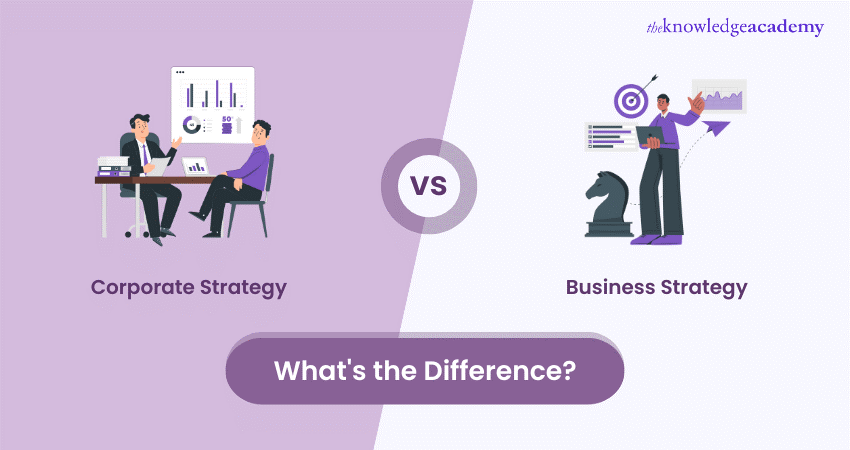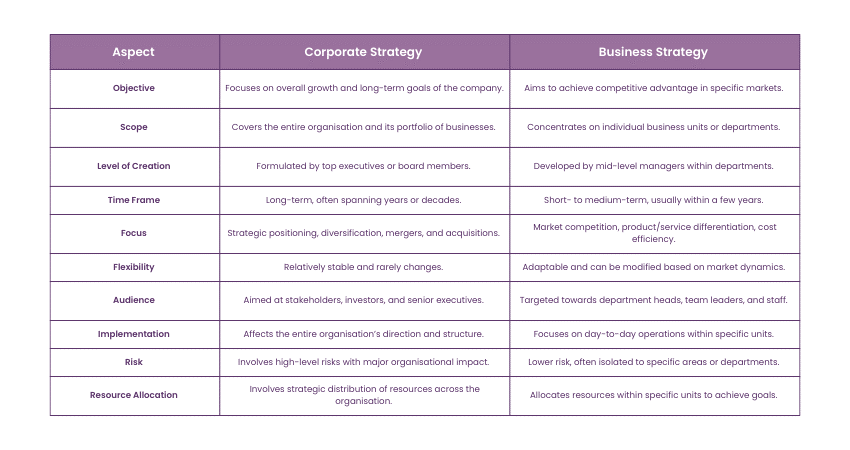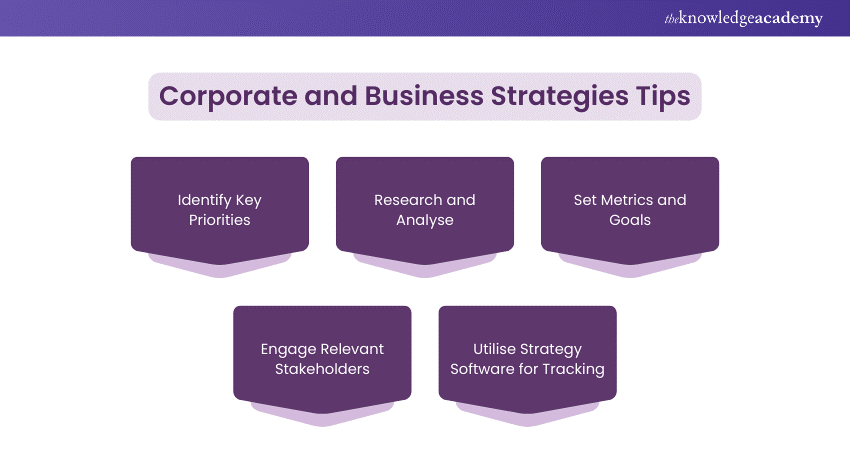We may not have the course you’re looking for. If you enquire or give us a call on 01344203999 and speak to our training experts, we may still be able to help with your training requirements.
We ensure quality, budget-alignment, and timely delivery by our expert instructors.

In the dynamic business market, strategy gives the right direction for organisational success. However, not all strategies are the same. Leaders and strategists must grasp the nuances between Corporate Strategy vs Business Strategy. Both are crucial for growth but differ in scope, purpose, and impact on an organisation’s trajectory.
Many professionals often conflate these strategies, yet they serve distinct functions. Understanding Corporate Strategy vs Business Strategy enables decision-makers to allocate resources effectively, optimise operations, and maintain a competitive edge.
This blog explores each strategy type, highlights their key differences, and offers actionable tips to help businesses align their goals and build a strong strategic foundation.
Table of Contents
1) What is Corporate Strategy?
2) What is Business Strategy?
3) Differences Between Corporate Strategy and Business Strategy
4) Effective Strategies of Business and Corporate Strategies
5) Business and Corporate Strategies Examples
6) Corporate and Business Strategies Tips
7) Conclusion
What is Corporate Strategy?
A Corporate Strategy is a comprehensive, long-term approach that directs an organisation's foundational decisions and resource distribution to optimise value generation. It outlines the markets, companies, and methods of expansion aimed at achieving the corporate vision. Although inherently connected, these strategies operate on different levels and fulfill distinct objectives.
The ROI Driven Corporate Training Guide emphasizes that corporate strategy typically operates at a macro level, encompassing decisions on diversification, geographic scope, and business sectors. It provides a broad perspective that supports long-term objectives and steers the organization as a whole rather than focusing on individual departments or units. Becoming a Corporate Trainer within such a strategy allows for the alignment of training programs that help the entire organization move towards these unified goals.
Effective corporate strategies empower a company to utilise its resources efficiently, foster synergy among different business units, and remain pertinent in a competitive international marketplace.
What is Business Strategy?
A business strategy is a tactical, short-term plan that specifies how a department or business unit in a company will meet particular goals and objectives in accordance with the broader corporate strategy. It aims to enhance its competitive stance and increase its market presence.

Business Strategy typically focuses on competitive positioning, product differentiation, customer targeting, and cost effectiveness. This strategic level aims to bolster the overall corporate strategy by executing targeted actions that enable each unit to achieve its objectives and succeed in its specific market.
Fundamentally, business strategy focuses on making certain that each part of the organisation operates at its best, aiding in the attainment of the broader corporate vision.
Empower your teams with our Performance Management Training Join us today!
Differences Between Corporate Strategy and Business Strategy
Business strategies and corporate-level strategies mainly differ in their goals. A business strategy is centered on marketplace competition, whereas a corporate strategy emphasises growth and profitability. Corporate strategies operate at a more elevated level than business strategies do.

1) Objective
Department heads focus on implementing business strategies to meet specific departmental goals, while senior managers employ corporate strategies to drive overall company growth.
Department Heads (Mid-Level Managers):
a) Implement business strategies within their divisions.
b) Aim to meet specific targets and objectives.
c) Ensures efficiency and success at the departmental level.
Senior Managers (e.g., CEOs):
a) Develop and execute corporate strategies.
b) Focus on company-wide growth aligned with long-term vision.
c) Relevant to the entire organisation, ensuring unified direction.
2) Benefits
Although the primary advantage of a business or corporate strategy is consistent—achieving success and profitability for the organisation—each method offers unique benefits.
The advantages of developing a Business Strategy consist of:
a) Having clear direction
b) Making better business decisions
c) Gaining a competitive advantage in the market
d) Improving a product or service's performance
The benefits of creating a Corporate Strategy include:
a) Ensuring efficient operations
b) Providing long-term sustainability
c) Ensuring the company follows its vision and mission statement
d) Maximising profits
3) Uses
Corporate Strategy:
a) Used for strategic decision-making at the top level.
b) Involves actions like mergers, acquisitions, and market expansion.
c) Guides the overall direction and growth of the organisation.
Business Strategy:
a) Applied within existing markets.
b) Focuses on customer acquisition, market positioning, and revenue growth.
c) Targets specific business sectors for competitive advantage.
4) Level
Corporate Strategy:
a) Developed at the executive or board level.
b) Affects the entire organisation.
Business Strategy:
a) Managed by middle management.
b) Concentrates on specific departments or units.
5) Creator
Corporate Strategy:
a) Devised by senior executives or board members.
b) Created by individuals with deep knowledge of the organisation’s overarching objectives.
Business Strategy:
a) Developed by managers specialised in their respective fields.
b) Formulated by those who understand the operational specifics of particular markets.
6) Time Frame
Corporate Strategy:
a) Adopts a long-term perspective.
b) Often spans multiple years or even decades.
Business Strategy:
a) Operates on a shorter timeline.
b) Features initiatives implementable within months or a few years.
7) Audience
Corporate Strategy:
a) The audience includes stakeholders, investors, and senior executives.
Business Strategy:
b) Targeted toward mid-level managers, team leaders, and staff members responsible for executing initiatives.
8) Duration
Corporate Strategy:
a) Generally stable and rarely changes.
Business Strategy:
a) Flexible and can be modified based on market conditions or unit performance.
9) Focus
Corporate Strategy:
a) Targets the organisation’s entire portfolio.
b) Seeks comprehensive growth and development.
Business Strategy:
a) Focuses on specific products, services, or market segments.
b) Aims to achieve and maintain a competitive advantage in targeted areas.
Effective Strategies of Business and Corporate Strategies
To achieve optimal effectiveness, corporate and business strategies need to be aligned and cohesive. The corporate strategy should offer a vision and framework that guides the business strategy. In turn, the business strategy should interpret this vision and implement it to address the specific needs of each market or segment.
This synergy ensures that every part of the organisation contributes to the company’s overarching goals.
Transform your vision of strategies into action with our Executive Strategy Training Sign up today!
Business and Corporate Strategies Examples
To demonstrate the interaction between business and corporate strategies, let's examine two instances where company and department-level plans support one another:
Example 1: Software Firm A software firm targets a 20% rise in annual recurring revenue within 3 years (corporate strategy). The lead generation team aims to obtain 25% additional marketing-qualified leads every quarter (business strategy). Effectively implementing campaigns and initiatives to transform more high value leads directly drives sales and revenue increase across the company.
Example 2: A hospital network aims to enhance community health results by 4 basis points each year through preventive care (corporate approach). The cardiology division initiates a target of decreasing readmission rates for heart-related events by 15% within 3 years (business strategy). Meeting this business-level goal reduces unnecessary usage for a widespread condition, addressing the system-level population health priorities.
In each instance, the corporate strategy is supported by the business strategy through coordinated actions and measurements. This sharpens choices and links workers to a common goal.
Corporate and Business Strategies Tips
The following are the Corporate and Business Strategies Tips:

1) Identify Key Priorities
At the organisational level, reflect on your company’s mission and vision. This reflection will help clarify the company’s direction, enabling you to envision a path forward. Alongside this exercise, consider these key questions:
a) What is the purpose of our organisation?
b) What problem are we aiming to solve?
c) What is our vision for the future?
d) Where should we allocate resources to maximise our chances of success?
On the departmental level, particularly within the Business department, review the corporate strategic plan to fully understand how progress will be tracked and evaluated. Then, assess your department’s strengths in alignment with these strategic goals. Additionally, when hiring a Corporate Trainer, asking the right Corporate Trainer Interview Questions can help ensure they are equipped to support these goals and contribute effectively to your department’s success.
2) Research and Analyse
To strengthen your strategic concepts, thoroughly examine your organisation and the existing external landscape using SWOT and PEST analyses. Consider the results while you formulate your strategy.
Comprehensive research and analysis of market trends and competitors are crucial for both corporate and business strategies. This will assist in identifying areas for enhancement, development, and creativity.
3) Set Metrics and Goals
After clarifying your objectives, it’s essential to establish metrics to monitor advancement and identify crucial projects that will contribute to achieving those objectives. Establishing specific, quantifiable goals allows for the assessment of strategy efficacy. Establish KPIs at both the corporate and business levels to track advancement and make adjustments as needed.
4) Engage Relevant Stakeholders
At the corporate level, top executives ought to engage from the outset. Without their support, your strategic plan is unlikely to succeed. As a department head, you are accountable for developing your business strategy, but you might need to seek input from team members regarding specific elements of the plan (such as timing or metrics).
Furthermore, ensure that you discuss the suggested strategy with superiors to confirm that everyone is aligned.
5) Utilise Strategy Software for Tracking
Creating a strategy is important, but without monitoring progress, you won't be able to identify where you're excelling and where you're lacking. Strategy reporting software is effective for both corporate and business strategies, simplifying the assessment of each component's progress and how corporate performance management influences other aspects.
How much does a Regulatory Analyst Salary vary by experience? Find out now and explore potential income growth in this in-demand role!
Conclusion
Understanding the difference between Corporate Strategy vs. Business Strategy is crucial for building a strong foundation. Corporate strategy sets the overall direction and market positioning, while business strategy targets specific goals within that framework. Together, they ensure every part of the organisation contributes to the overall vision and success. By Following these businesses can achieve growth targets and sustain success in a competitive landscape.
Elevate your management skills with our Management Training For New Managers Register now!
Frequently Asked Questions
What are the Limitations of Corporate Strategies?

Corporate strategies encounter constraints such as substantial resource requirements, sluggish adaptability, intricate execution, and dangers associated with excessive diversification. They rely on precise forecasting, risk escalating bureaucracy, and could misalign with operational tiers.
What are the Key Elements of a Business Strategies?

Essential components of a business strategy consist of vision, fundamental values, market assessment, target market, and distinct value proposition. It establishes objectives, competitive strengths, distribution of resources, and operational strategies. Performance indicators and risk management guarantee the strategy is measurable.
What are the Other Resources and Offers Provided by The Knowledge Academy?

The Knowledge Academy takes global learning to new heights, offering over 30,000 online courses across 490+ locations in 220 countries. This expansive reach ensures accessibility and convenience for learners worldwide.
Alongside our diverse Online Course Catalogue, encompassing 19 major categories, we go the extra mile by providing a plethora of free educational Online Resources like News updates, Blogs, videos, webinars, and interview questions. Tailoring learning experiences further, professionals can maximise value with customisable Course Bundles of TKA.
What is The Knowledge Pass, and How Does it Work?

The Knowledge Academy’s Knowledge Pass, a prepaid voucher, adds another layer of flexibility, allowing course bookings over a 12-month period. Join us on a journey where education knows no bounds.
What are the Related Courses and Blogs Provided by The Knowledge Academy?

The Knowledge Academy offers various Management Courses, including the Senior Management Training, Performance Management Training and the Business Process Improvement Training. These courses cater to different skill levels, providing comprehensive insights into Corporate Finance Professionals.
Our Business Skills Blogs cover a range of topics related to Executive Strategy Training, offering valuable resources, best practices, and industry insights. Whether you are a beginner or looking to advance your Strategies skills, The Knowledge Academy's diverse courses and informative blogs have got you covered.
Upcoming Business Skills Resources Batches & Dates
Date
 Executive Strategy Training
Executive Strategy Training
Fri 4th Apr 2025
Fri 27th Jun 2025
Fri 29th Aug 2025
Fri 24th Oct 2025
Fri 5th Dec 2025






 Top Rated Course
Top Rated Course



 If you wish to make any changes to your course, please
If you wish to make any changes to your course, please


